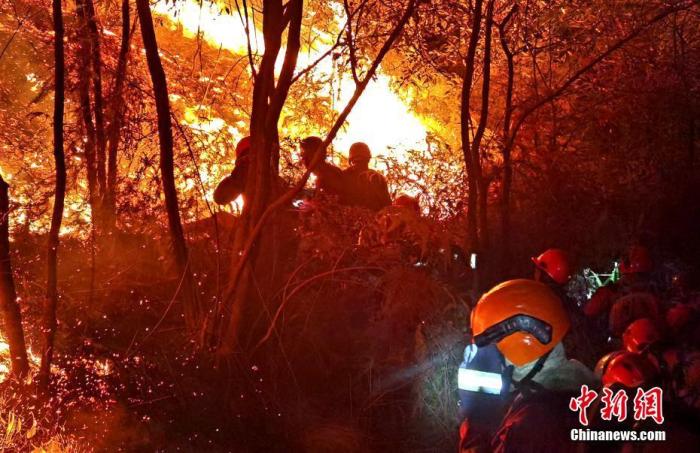China News Service, May 7th. At the press conference of the State Council Information Office today, Peng Xiaoguo, deputy director of the Forest Fire Bureau of the Ministry of Emergency Management and director of the Fire Prevention Management Department, said that from January to April this year, a total of 466 forest fires occurred across the country. According to preliminary statistics, the damaged forest area is about 2,272 hectares. Compared with the same period in 2020, the number of fires has decreased by 32.1%, and the area affected has decreased by 58.6%. Compared with the average of the same period in the past five years, the number of fires has decreased by 71.8%. The drop was 63.5%.
Compared with the average value of the past five years, the number of grassland fires and the area affected have also fallen sharply.
Peng Xiaoguo pointed out that after May 1st, 10 provinces across the country ended the spring fire prevention period, but this does not mean that the pressure on prevention and control will be greatly eased. Some key areas not only cannot relax, but must also be implemented with higher standards. Good precautions.
Especially in May, the fire prevention and control situation in the northern region, where the pressure is greatest, has become increasingly severe, while the fire danger situation in parts of the southwest continues to be high, showing the characteristics of overlap between north and south.
After summer, the primitive forest areas of Northeast China and Inner Mongolia entered into an active period of lightning fires. Regularly speaking, there may be multiple simultaneous outbreaks. In autumn and winter, the forest areas of North China and South China are predicted to be dry and less rainy, with a wide range of high fire risk levels and a long duration. Can't tolerate carelessness.
Data map: On the evening of February 5, Fujian forest fire rescue personnel put out a forest fire overnight.
China News Agency issued a photo for Longyan Forest Fire Fighting
Peng Xiaoguo said that the next step will focus on the following aspects:
One is to strengthen source control.
We will do a good job in mass prevention and management and joint prevention and control, focus on the rectification of key hidden dangers, strengthen the early treatment of fire conditions, and strictly organize the nationwide special operations for the management of wild fire sources and the investigation and punishment of illegal fire use, and make every effort to resolve the risk of disasters. At the time of budding, before the disaster.
The second is to promote both symptoms and root causes.
Starting from improving policy mechanisms, planning project construction, enhancing professional capabilities, and strengthening scientific and technological equipment support, we will vigorously improve the modernization of forest and grassland fire prevention and control.
At present, we are studying and formulating the "Opinions on Comprehensively Strengthening Forest and Grassland Fire Fighting Work", speeding up the compilation and revision of the "Forest and Grassland Fire Fighting Regulations" and related standard systems, and addressing both symptoms and root causes to promote the upgrading of fire fighting work.
The third is to speed up making up for shortcomings.
Instruct all localities to continue to do a good job in infrastructure construction, focus on promoting the construction of fire isolation belts, fire pipelines and other facilities around important targets such as urban forest-side residential areas, oil (gas) stations, and chemical plants, and accelerate the construction of a gridded prevention and control pattern; continue; Do a good job in the construction of professional fire fighting teams, strengthen the construction of forest aviation firefighting forces, and strengthen the innovation and application of tactics in integrated air and ground operations and coordinated operations.
The fourth is to make real preparations for the save.
In April, on the basis of coordinating the nationwide prevention and control work, the topic organized the task of responding to the major forest and grassland fires in the Northeast and Inner Mongolia and the fire prevention in the Winter Olympics area. The task will be followed up in the next step. Promote detailed implementation of various tasks, strengthen monitoring and early warning and dynamic consultation, research and judgment; instruct localities to improve various types of plans at all levels, strengthen training and exercises, and fully implement the "three forwards" of command, strength, and equipment, and timely in key and sensitive areas Preset maneuvering forces in advance to ensure effective response and efficient disposal in major fire situations.
Fifth, keep the bottom line of safety firmly.
On the basis of the centralized organization of online training for national commanders last year and the guidance of various localities in the synchronization of fire fighting safety special training, the recent national "Fire Fighting Safety Warning Education and Remediation Week" was organized and the "Forest and Grassland Fire Fighting Business Lecture Hall" was organized. ", and formed an "instructor team" to organize first-line commander training in various provinces to promote the solid establishment of the concept of "people first and life first" in all regions, and comprehensively improve the scientific organization and command and safe fire fighting capabilities at all levels.
These tasks will continue to advance to achieve uninterrupted work and full coverage during the year.
At the same time, continue to guide localities to improve the on-site command mechanism, strengthen professional command, standardize fire site management, and implement safety precautions. In particular, the principle of "detecting unclear fire first, waiting first with unfavorable weather, and avoiding first with unfavorable terrain" is conscientiously implemented in fighting operations. Resolutely abide by the bottom line of safety.

